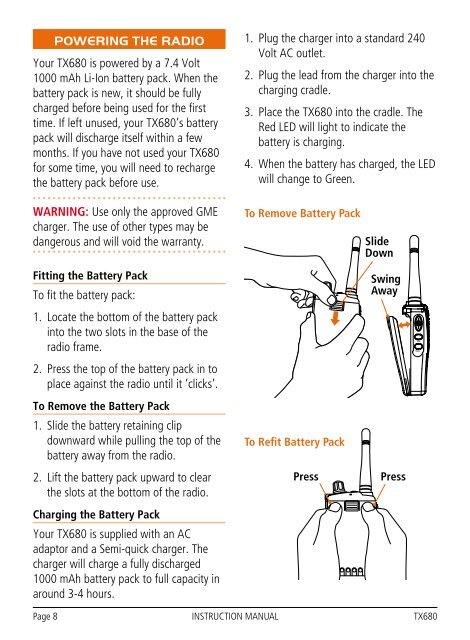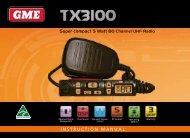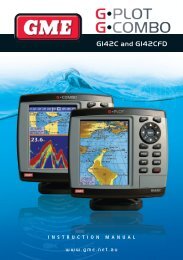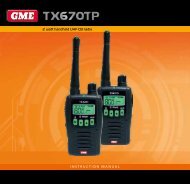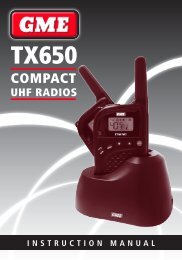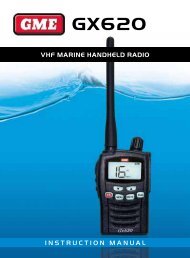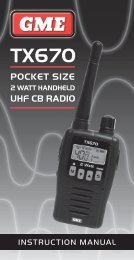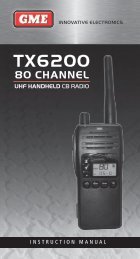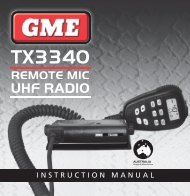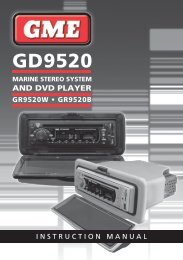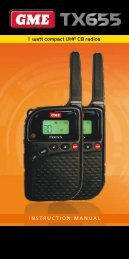PDF Manual - GME
PDF Manual - GME
PDF Manual - GME
You also want an ePaper? Increase the reach of your titles
YUMPU automatically turns print PDFs into web optimized ePapers that Google loves.
POWERING THE Radio<br />
Your TX680 is powered by a 7.4 Volt<br />
1000 mAh Li-Ion battery pack. When the<br />
battery pack is new, it should be fully<br />
charged before being used for the first<br />
time. If left unused, your TX680’s battery<br />
pack will discharge itself within a few<br />
months. If you have not used your TX680<br />
for some time, you will need to recharge<br />
the battery pack before use.<br />
WARNING: Use only the approved <strong>GME</strong><br />
charger. The use of other types may be<br />
dangerous and will void the warranty.<br />
Fitting the Battery Pack<br />
To fit the battery pack:<br />
1. Locate the bottom of the battery pack<br />
into the two slots in the base of the<br />
radio frame.<br />
2. Press the top of the battery pack in to<br />
place against the radio until it ‘clicks’.<br />
To Remove the Battery Pack<br />
1. Slide the battery retaining clip<br />
downward while pulling the top of the<br />
battery away from the radio.<br />
2. Lift the battery pack upward to clear<br />
the slots at the bottom of the radio.<br />
Charging the Battery Pack<br />
Your TX680 is supplied with an AC<br />
adaptor and a Semi-quick charger. The<br />
charger will charge a fully discharged<br />
1000 mAh battery pack to full capacity in<br />
around 3-4 hours.<br />
1. Plug the charger into a standard 240<br />
Volt AC outlet.<br />
2. Plug the lead from the charger into the<br />
charging cradle.<br />
3. Place the TX680 into the cradle. The<br />
Red LED will light to indicate the<br />
battery is charging.<br />
4. When the battery has charged, the LED<br />
will change to Green.<br />
To Remove Battery Pack<br />
To Refit Battery Pack<br />
Press<br />
Slide<br />
Down<br />
Swing<br />
Away<br />
Press<br />
Battery Low Alert<br />
When the battery icon blinks on the<br />
display, the battery level is low and the<br />
battery pack should be recharged. If the<br />
battery is not charged, an audio tone<br />
will then sound to warn the user that the<br />
battery is almost discharged.<br />
Battery Usage<br />
The time taken to discharge the battery<br />
pack will depend on how you use the<br />
TX680. The1000 mAh battery pack<br />
supplied is powerful enough for a full days<br />
use under average conditions.<br />
Conserving Battery Power<br />
The TX680 has built-in power saving<br />
features to help you get the maximum<br />
amount of time between charges from<br />
your Li-Ion battery pack. If you need to<br />
operate your TX680 in a situation where<br />
you require maximum battery life (e.g. a<br />
remote site where there is no convenient<br />
recharging facility nearby) the following<br />
hints can greatly reduce the amount of<br />
power drawn from the battery pack.<br />
Standby Mode<br />
The TX680 will automatically enter the<br />
‘Standby’ mode when it is inactive (i.e.<br />
not transmitting or receiving signals.<br />
While in Standby mode it will still check<br />
for incoming signals but it will draw<br />
considerably less power from the battery<br />
pack. As soon as a signal is heard or the<br />
keys are pressed the TX680 will ‘wake up’<br />
again. This Standby mode is automatic<br />
and by itself can extend the battery life by<br />
many hours.<br />
Using CTCSS<br />
If you are expecting to receive signals on<br />
a busy channel, you can program that<br />
channel for CTCSS operation and get the<br />
other person to call you using the same<br />
CTCSS tone. Your radio will then remain in<br />
Standby and ignore all other signals until<br />
your selected CTCSS tone is received.<br />
Scanning<br />
The TX680 draws more power from the<br />
battery pack when scanning than when<br />
monitoring a single channel. This is<br />
because it must ‘wake up’ more often to<br />
monitor each channel for activity. You<br />
can squeeze that extra bit of life from the<br />
battery pack by avoiding any unnecessary<br />
scanning. In addition, scanning increases<br />
the chance of finding a signal thereby<br />
keeping the receiver ‘awake’ and the<br />
squelch open more often.<br />
Low Transmit Power Settings<br />
The transmitter has both high and low<br />
power settings. If you are only operating<br />
over short distances, are in a reasonably<br />
high location or are close to a local<br />
repeater, try using the Low transmitter<br />
power setting. This reduces the transmitter<br />
power from 3 watts to 1 watt effectively<br />
doubling the talk time available.<br />
Page 8 INSTRUCTION MANUAL TX680 TX680 INSTRUCTION MANUAL Page 9


